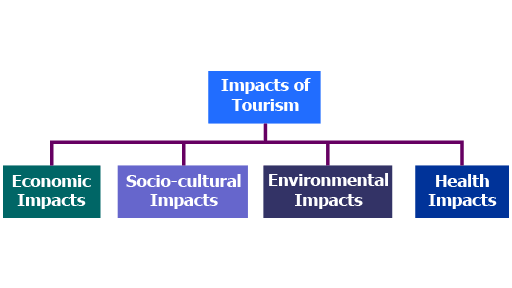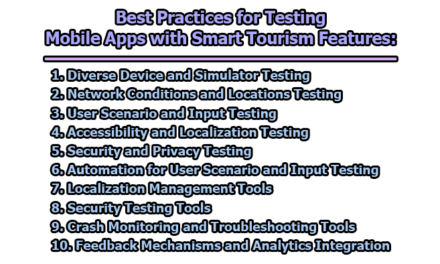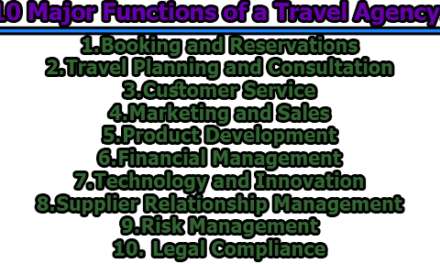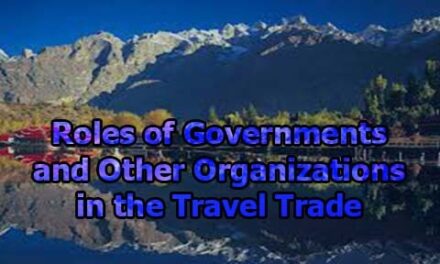Tourism refers to the activity of individuals or groups of people traveling to and staying in places outside their usual environment for leisure, business, or other purposes. It involves a wide range of activities such as sightseeing, visiting cultural or historical sites, engaging in adventure sports, attending business meetings, or simply relaxing on a beach. Tourism can be domestic or international and can have a significant impact on the economies of the destinations visited. In the rest of this article, we will explore the forms and impacts of tourism.
Definitions of Tourism:
There are several definitions are found in the term tourism which all are not equally important, some of the necessary definitions are given below:
“Tourism is the world’s largest industry, yet it is one of the most fragile. It has the power to unite cultures and break down barriers, but it also has the potential to destroy natural and cultural resources if not managed responsibly.” – Dr. Kelly S. Bricker
“Tourism is the perfect storm of globalism, capitalism, and consumerism. It is the embodiment of the human desire to explore and discover, but it is also the manifestation of our insatiable need for instant gratification and consumption.” – Elizabeth Becker
“Tourism is not just about traveling to new places, it is about understanding and appreciating the diversity of our world. It is about recognizing the commonalities that bind us as humans while celebrating the differences that make us unique.” – Taleb Rifai
From the above definitions, we can say that tourism is the art of seeing what is invisible to others and making it visible for everyone to enjoy.
Forms of Tourism:
Here is a brief overview of the various forms of tourism:
- Domestic Tourism: Domestic tourism refers to travel within one’s own country for leisure, recreation, or other purposes. It involves visiting different regions, cities, or attractions within the same country. Domestic tourism is an essential component of the tourism industry, as it contributes significantly to the economy by generating employment, income, and revenue. It is also an excellent opportunity for locals to explore their own country’s culture, history, and natural beauty.
- International Tourism: International tourism involves traveling to a foreign country for leisure, business, or other purposes. It is one of the fastest-growing industries globally and contributes significantly to the economy of many countries. International tourism offers travelers the opportunity to experience new cultures, traditions, cuisines, and natural beauty that are not available in their home countries. It also provides an opportunity for countries to showcase their unique attractions and cultural heritage to the world.
- Outbound Tourism: Outbound tourism refers to residents of one country traveling to other countries for leisure, business, or other purposes. Outbound tourism is significant for countries that have a high level of disposable income as it contributes to their tourism industry’s growth. Outbound tourism enables people to experience different cultures, meet new people, and create lasting memories.
- Inbound Tourism: Inbound tourism refers to travelers from foreign countries visiting another country for leisure, business, or other purposes. Inbound tourism is vital to a country’s economy as it generates foreign exchange earnings, creates employment opportunities, and promotes cultural exchange. Inbound tourism also provides an opportunity for a country to showcase its unique attractions, cultural heritage, and hospitality.
- Business Tourism: Business tourism involves traveling for business or professional purposes such as attending conferences, meetings, trade shows, or exhibitions. It is an essential component of the tourism industry as it generates significant revenue for the hospitality and transportation sectors. Business tourism also promotes international trade, creates employment opportunities, and fosters cultural exchange.
- Adventure Tourism: Adventure tourism involves traveling to remote or exotic locations to engage in physically challenging and adventurous activities such as mountaineering, trekking, bungee jumping, and white-water rafting. Adventure tourism is popular among young adults and adventure enthusiasts who seek unique and thrilling experiences.
- Wildlife Tourism: Wildlife tourism involves traveling to natural areas to observe and learn about wildlife. It includes activities such as safari tours, bird watching, and wildlife photography. Wildlife tourism promotes the conservation of natural habitats and the protection of endangered species.
- Medical Tourism: Medical tourism involves traveling to another country for medical treatment or procedures. It is primarily driven by the cost savings of medical procedures in countries where healthcare costs are lower than in the traveler’s home country. Medical tourism also provides an opportunity for patients to access medical procedures that are not available in their home countries.
- Wellness Tourism: Wellness tourism involves traveling to a destination to maintain or improve one’s health and well-being. It includes activities such as spa treatments, yoga, meditation, and fitness programs. Wellness tourism is driven by the increasing awareness of the importance of maintaining a healthy lifestyle and the desire for self-care and relaxation.
- Religious Tourism: Religious tourism involves traveling to a destination for religious or spiritual purposes. It includes visiting religious sites, attending religious festivals, and participating in religious ceremonies. Religious tourism is driven by the desire for spiritual enrichment and a deeper connection with one’s faith.
- Cultural Tourism: Cultural tourism involves traveling to a destination to learn about and experience the local culture, heritage, and traditions. It includes activities such as visiting museums, historical sites, and monuments, attending cultural events and festivals, and engaging with local communities. Cultural tourism promotes cultural exchange and understanding and helps to preserve and promote the local culture.
- Dark Tourism: Dark tourism involves traveling to destinations associated with death, tragedy, or suffering. It includes visiting sites of natural disasters, war zones, memorials, and historical sites related to genocide or human rights violations. Dark tourism is driven by curiosity, a desire to understand history, and the desire to pay respects to the victims of tragic events.
- Culinary Tourism: Culinary tourism involves traveling to a destination to explore and experience the local cuisine and culinary traditions. It includes activities such as visiting local markets, attending cooking classes, and dining at local restaurants. Culinary tourism is driven by the increasing interest in food culture, the desire for unique gastronomic experiences, and the desire to learn about local culinary traditions.
- Celebrity Tourism or Film Tourism: Celebrity tourism or film tourism involves traveling to destinations associated with famous personalities, film locations, or television shows. It includes visiting locations where movies or television shows were filmed, attending events related to celebrities, and visiting the homes or gravesites of famous personalities. Celebrity tourism or film tourism is driven by the fascination with celebrity culture and the desire to be closer to famous people.
- Educational Tourism: Educational tourism involves traveling to a destination for educational purposes. It includes attending language schools, cultural immersion programs, and academic courses at universities or other educational institutions. Educational tourism promotes cross-cultural learning and understanding and provides an opportunity for students to gain knowledge and skills from different perspectives.
- Cruise Tourism: Cruise tourism involves traveling by ship to various destinations for leisure or pleasure. It includes activities such as onboard entertainment, dining, and shore excursions. Cruise tourism is driven by the desire for a unique and luxurious travel experience, and the opportunity to explore multiple destinations in a single trip.
- Rural Tourism: Rural tourism involves traveling to rural areas to experience the local culture, heritage, and natural beauty. It includes activities such as farm stays, rural homestays, and outdoor activities such as hiking, fishing, and camping. Rural tourism promotes sustainable tourism practices, supports local economies, and provides an opportunity for visitors to connect with nature.
In summary, the different forms of tourism offer a diverse range of experiences and opportunities for travelers. From adventure tourism to wellness tourism, each form of tourism has its unique features, attractions, and benefits. By promoting sustainable tourism practices, preserving cultural heritage, and fostering cross-cultural understanding, tourism can serve as a powerful force for economic development, cultural exchange, and global harmony.
Impacts of Tourism:
Tourism has become an integral part of many economies worldwide and has a significant impact on society, culture, environment, and health. While tourism can bring substantial benefits to destinations, it can also have negative impacts if not managed sustainably. Here, we will discuss the impacts of tourism in four areas: economic, socio-cultural, environmental, and health.
– Economic Impacts: Tourism can have a significant impact on the economy of a destination. It can generate employment, contribute to the gross domestic product (GDP), and boost the local economy. Tourism can also create business opportunities for entrepreneurs and stimulate the growth of related industries such as transportation, accommodation, and food service.
However, the economic impacts of tourism can also have negative consequences. The tourism industry is highly seasonal, and destinations may experience a decline in tourism during off-peak periods, resulting in a decrease in revenue and employment opportunities. In addition, tourism can lead to price inflation and cause local residents to be displaced due to higher living costs.
– Socio-cultural Impacts: Tourism can have significant socio-cultural impacts on a destination. It can lead to the preservation or destruction of cultural heritage, alter the social and cultural values of local residents, and change the social structure of the destination.
Tourism can bring cultural exchange and understanding between visitors and local residents, leading to positive impacts on local culture. However, tourism can also lead to the commercialization of cultural heritage, resulting in the loss of authenticity and cultural identity. Furthermore, tourism can also cause social problems, such as increased crime rates, cultural clashes between visitors and residents, and social inequality.
– Environmental Impacts: Tourism can have significant environmental impacts on a destination. It can lead to the degradation of natural resources, such as water, air, and land, and contribute to climate change. Tourism can also cause the destruction of ecosystems, wildlife habitats, and endangered species.
Tourism can promote environmental conservation by generating revenue for conservation efforts, supporting sustainable tourism practices, and promoting awareness of environmental issues. However, tourism can also lead to the overconsumption of natural resources, pollution, and waste generation.
– Health Impacts: Tourism can have significant health impacts on both visitors and local residents. It can lead to the spread of infectious diseases, physical injuries, and mental health problems. Tourism can also contribute to stress and fatigue due to the disruption of daily routines and exposure to new environments.
Tourism can promote health and wellness by offering activities such as spa treatments, outdoor recreation, and cultural immersion programs. However, tourism can also contribute to health problems, such as exposure to pollution, increased alcohol consumption, and the spread of sexually transmitted infections.
In conclusion, the impacts of tourism can be both positive and negative, depending on how it is managed. To maximize the positive impacts and minimize the negative impacts, it is essential to adopt sustainable tourism practices, promote cultural exchange and understanding, preserve natural resources and cultural heritage, and prioritize the health and well-being of visitors and local residents. By adopting a holistic approach to tourism management, destinations can ensure that tourism contributes to sustainable development and the well-being of all stakeholders involved.
References:
- Cooper, C., Fletcher, J., Fyall, A., Gilbert, D., & Wanhill, S. (2017). Tourism: Principles and Practice. Pearson.
- Gössling, S., Scott, D., & Hall, C. M. (2013). Tourism and water: Interactions, impacts, and challenges. Channel View Publications.
- Hall, C. M., Timothy, D. J., & Duval, D. T. (2012). Safety and security in tourism: relationships, management, and marketing. Routledge.
- Page, S. J., & Connell, J. (2014). Tourism: A modern synthesis (3rd ed.). Cengage Learning.
- Weaver, D. B., & Lawton, L. J. (2014). Tourism management (5th ed.). Wiley.
- Witt, S. F., & Moutinho, L. (2020). Tourism marketing and management handbook. Routledge.

Library Lecturer at Nurul Amin Degree College










